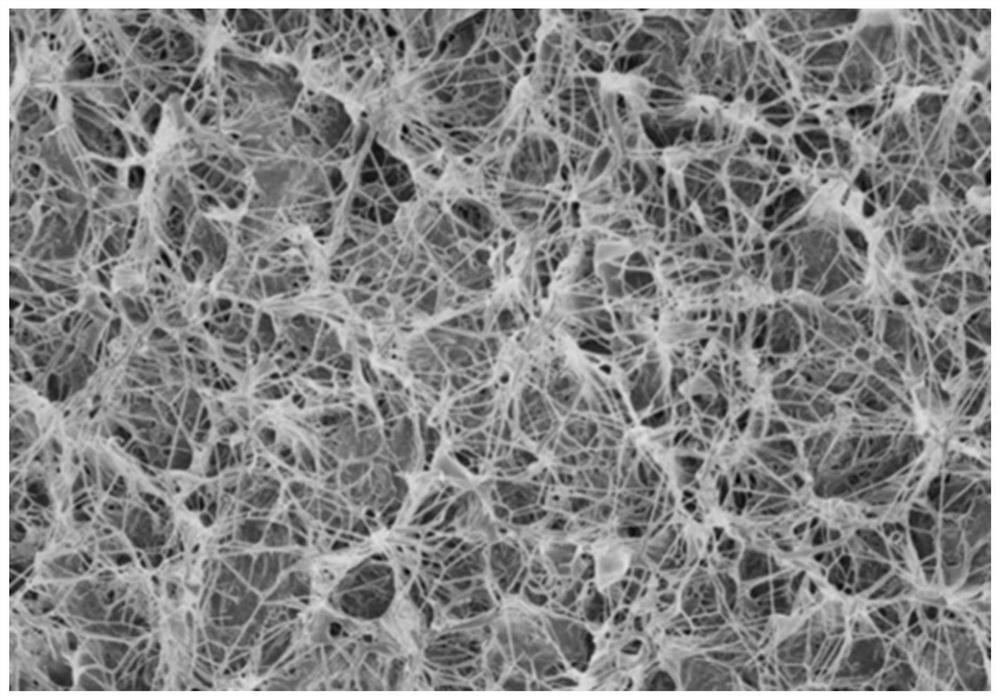Polyethylene microporous membrane as well as preparation method and application thereof
A polyethylene microporous membrane and polyethylene technology, applied in electrical components, circuits, battery pack components, etc., can solve problems such as unsuitable for industrial applications, limited diaphragm performance, wide liquid-liquid phase separation area, etc., and achieve good industrial Effect of application prospect, excellent air permeability and mechanical strength
- Summary
- Abstract
- Description
- Claims
- Application Information
AI Technical Summary
Problems solved by technology
Method used
Image
Examples
preparation example Construction
[0030] The invention provides a preparation method of a polyethylene microporous membrane, comprising: mixing polyethylene with a composite diluent to obtain a premix, wherein the polyethylene accounts for 20% to 60% by mass of the premix, and the composite diluent accounts for The mass percentage of the premix is 40% to 80%; the premix is melt-extruded and cooled to form a primary film; the diluent in the primary film is removed by an extractant, and then heat-treated to obtain a polyethylene microporous film; wherein the composite diluent includes a high-temperature solvent and a non-solvent, and the high-temperature solvent is selected from myristic acid, palmitic acid, octadecanoic acid, eicosic acid, behenic acid, myristyl alcohol, cetyl alcohol, stearyl alcohol and One or more of eicosanol, preferably myristyl alcohol, cetyl alcohol, stearyl alcohol or eicosanol; the non-solvent is selected from benzophenone, diphenyl carbonate and dimethyl sulfone One or more of the...
Embodiment 1
[0052] Mix polyethylene (viscosity-average molecular weight 1,500,000Da, average particle size 150μm) with composite diluent cetyl alcohol and benzophenone to form a premix, wherein polyethylene mass percent is 35%, cetyl alcohol mass percent is 50 %, the mass percentage of benzophenone is 15%. The premixed material was added into a screw extruder, melted and mixed uniformly to form a film-forming liquid, wherein the melting temperature was 130°C. The film-making solution is molded by an extruder and poured into cooling water to solidify to obtain a nascent film. The cooling temperature is 25°C. The obtained nascent film is stretched horizontally and vertically, and then immersed in ethanol for extraction to remove cetyl alcohol and benzophenone. The extracted film was heat-treated in water at 90° C. for 60 min to obtain a polyethylene microporous film.
[0053] figure 2 It is the scanning electron micrograph of the polyethylene microporous membrane of embodiment 1. like ...
Embodiment 2
[0055] The polyethylene microporous membrane is prepared according to the method of Example 1, the difference is that the composite diluent is cetyl alcohol and diphenyl carbonate, wherein the polyethylene mass percentage is 35%, the cetyl alcohol mass percentage is 50%, and diphenyl carbonate The mass percentage of ester is 15%. There is a phenomenon of liquid-liquid phase separation in this system. The microporous membrane was tested for mechanical properties, air permeability and porosity. The results and the maximum polymer mass concentration corresponding to the liquid-liquid phase separation zone are shown in Table 1.
PUM
| Property | Measurement | Unit |
|---|---|---|
| particle size | aaaaa | aaaaa |
| viscosity average molecular weight | aaaaa | aaaaa |
| particle size | aaaaa | aaaaa |
Abstract
Description
Claims
Application Information
 Login to View More
Login to View More - R&D
- Intellectual Property
- Life Sciences
- Materials
- Tech Scout
- Unparalleled Data Quality
- Higher Quality Content
- 60% Fewer Hallucinations
Browse by: Latest US Patents, China's latest patents, Technical Efficacy Thesaurus, Application Domain, Technology Topic, Popular Technical Reports.
© 2025 PatSnap. All rights reserved.Legal|Privacy policy|Modern Slavery Act Transparency Statement|Sitemap|About US| Contact US: help@patsnap.com



